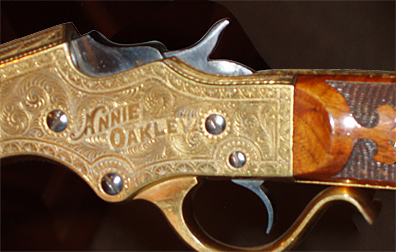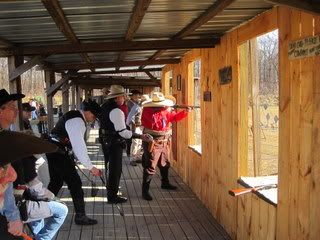

 The Accurate Reloading Forums
The Accurate Reloading Forums  THE ACCURATE RELOADING.COM FORUMS
THE ACCURATE RELOADING.COM FORUMS  Guns, Politics, Gunsmithing & Reloading
Guns, Politics, Gunsmithing & Reloading  Gun Collecting
Gun Collecting  What is the typical "halflife" of a gun?
What is the typical "halflife" of a gun?Go  | New  | Find  | Notify  | Tools  | Reply  |  |
| one of us |
I posted this in gunsmithing, also, but maybe here in "Gun Collecting" is the most appropriate place: We know that many/most guns eventually "go away" in the sense that some of them get broken or damaged, fall out of the boat into the lake, get burned up in house fires, are melted down in gun "buy backs", or wear to the point that they are scrapped or used for parts. If this weren't true and guns were around forever then there wouldn't be such a collector's market for Colt Walkers and Winchester 73's -- obviously a large portion of the production of these models has vanished and is no more. So, say 50, 75, or 100 years after production, how many of a given model would be expected to still be existing in functional form (regardless of how beat up or worn)? In other words, what percentage of the Winchester Model 70's or Savage 99's produced in 1939 (or any other model in any other year) are still with us 73 years later? Has anyone ever seen a study of this or any reliable estimates? | ||
|
| One of Us |
Just a WAG, but there are way too many variables involved to produce any degree of accuracy with such a prediction. Consider the U.S. Rifle Model 1903 as an example, and you will see what I mean. Mike ______________ DSC DRSS (again) SCI Life NRA Life Sables Life Mzuri IPHA "To be a Marine is enough." | |||
|
| one of us |
I'm sure that the rate of attrition varies by model and usage (war rifles being used up and destroyed faster than civilian ones, for example). But there should be some average for civilian arms in general usage. I just can't find any studies which would give a hint. | |||
|
| One of Us |
What makes you think there "should be"? There is no way to account for personally owned firearm longevity, unlike automobiles which require annual government registration. What you are looking for simply does not exist. Mike ______________ DSC DRSS (again) SCI Life NRA Life Sables Life Mzuri IPHA "To be a Marine is enough." | |||
|
| one of us |
By "should be", I suspect that collectors of various models have been able to make some determination about how many of them are still around. If there is data or estimates from such collectors then that some approximations could be inferred from that information. | |||
|
| One of Us |
Years ago I bought a Winchester Model 41 shotgun. It was actually a cheap single shot bolt action .410, but had a high collector value. Next years Blue Book had it listed about half what it had been year before. I talked to Steve Fjestad the publisher of Blue Book. He told me that based on the low number made, 22,145 and they were made 1920-1934 they expected many would have perished. After they listed the high value, they came out of the woodwork so to speak and there were actually many more available than suspected. A detective once told me if your TV gets stolen for example, they'll only keep the serial number a couple years or so, but firearms they keep forever. Years later if a firearm gets pawned even in another state they will know about it. | |||
|
| one of us |
So Fjestad grossly exaggerated the value and lots of guns showed up on the market in response? It wouldn't be the first time. Fjestad had a competitor who was convicted of market manipulation. "Blue" is the color of the hole such books should be thrown in. | |||
|
| One of Us |
Don't know if this adds anything to the conversation, but 6 or 7 years back, I bought a 1907 .351 Winchester Self Loader from a co-worker. He was selling it and a couple of other guns for a friend that was in ill health. Checking the serial numbers with Winchester came up with a date of manufacture in 1923. The gun is in fairly rough shape, fore-end and butt stock both have cracks, but a friend helped me out by working up useable brass with .357 Magnum brass and we experimented with different powder charges, in 2009 I used that gun to kill a coyote and two white tail does. I recently found a company that makes replacement butt stocks and fore ends for this model and that is the next project. So from a 1923 manufacture date to 2013 approximately 90 years, this one gun in particular is still fully functional and capable of killing game. As an example, here is a javelin I killed in west Texas in February of 2011 with the .351.  Shooting that critter without messing up his hat was the hard part. Even the rocks don't last forever. | |||
|
| One of Us |
Parts availability would be a huge factor in longevity of a gun. Years ago I traded for a Weatherby Patrician shotgun. Many people think Weatherby and high quality. Those folks have not looked at a Weatherby Patrician shotgun. Steveie Wonder could see CHEAP on this one. This one had a butt that had been shortened way too far and was missing the wood on the slide. The gun was under 25 years old and I checked into getting new wood (really didn't think it would be worth the cost). Wood was not available. I had Johnson and Evinrude outboard motors that were much older--yet parts readily available--same with Winchester guns. Had friend that wanted a shotgun to keep under his bed and would probably never shoot it. This Weatherby was the perfect candidate and I generously gave the gun to my friend. | |||
|
one of us |
To my way of thinking, this 'halflife' will vary greatly depending on who owns the gun. If the owner is a guy who thinks guns are a tool and never cleans, oils or takes care of them and throws them around. They will not last long. If on the other hand, it is some one who sees them as functional art and takes care of them, they will last forever. I have several over 50 years old that have never fired a shot and are just taken out and oiled and fondled from time to time, then returned to the safe. | |||
|
| One of Us |
Not everyone has the skills to hit that lethal nerve ending in the foot. ****************** "Policies making areas "gun free" provide a sense of safety to those who engage in magical thinking..." Glenn Harlan Reynolds | |||
|
| One of Us |
I have developed quite a reputation for shooting critters in the foot! Even the rocks don't last forever. | |||
|
| One of Us |
I think if a gun is built to a quality that the owner feels a pride in ownership the longevity quite long. I think one thing that often hurts is as times change certain guns are viewed as obsolete and get neglected. Old muzzleloaders, big bore single shot rifles and Damascus doubles suffered from that. | |||
|
| one of us |
I understand what the Stonecreek is trying to ask. It is a difficult question to answer as it has many variables. Such AS: How good a design/rugged was the original gun. How well was it treated/maintained. What environment was it used in, ie War, hunting, personal protection, competition, etc. There are just to many variables to come up with a definative answer, IMHO. Old military guns seem to have a high survival rate. I think this is because when they become "second rate, substandare, ie replaced by a newer model" they are still properly stored for issue if it becomes necessary. Just look at the number of Mausers, Mosin Nagants, SKS etc avialable now... Also look at thwe Garands avialable from the CMP. Privately owned guns in the US seem to be the most difficult to predict a "half life" as it depends on the care given to the individual gun, by the individual owners. I am sometimes appaled and the care, actually the lack of care, that some guns seem to have recieved. I know some guys that have had guns for over 40 years, they have used them a lot, shot them a lot, hunted with them a lot, and they still look as nearly new. I know other guys that have had guns for 3 or 4 years, and they look like they have been dragged behing the truck for several hundred miles, while driving to the deer lease. DOUBLE RIFLE SHOOTERS SOCIETY | |||
|
| one of us |
When loaned to my brother-in-law, about one hunt. | |||
|
| One of Us |
I'm going with what care and maintence a firearm has received since it was built. You still see century old rifles with pristine bores and good stocks. Witness the many springfields in 30-06 still alive and kicking. Then there are those who lavish little or no care in what they own. I once saw a rem1100 12 guage with pieces of pea gravel inside the receiver and the damage was truly shocking. Just about all the machined surfaces were chewed up and one gunsmith had told the owner it was unrepairable. Course the cracked bolt also probably had something to do with that. But rust, corrosion and neglect can and do take their toll over the years as has bubba. Frank | |||
|
| one of us |
Let me restate the question via example: Assume that there were 10,000 Remington Model XYZ .22 LR Pump rifles made during the period 1908-1919. In 2013, approximately one hundred years after the production run, how many of them are still in service? A. 900 B. 5,200 C. 9,150 D. fewer E. more | |||
|
| One of Us |
B A pump .22 is an interesting example in as much as they do (did) tend to fall into the hands of younger less careful users. Also, pumps tend to go loosey goosey and lose usability sooner than a single shot or bolt gun would. A lot of parts to wear/bind etc. I would think that as an average, about half of a production run lasts to the 100yr mark in servicable condition. | |||
|
| Powered by Social Strata |
| Please Wait. Your request is being processed... |
|
 The Accurate Reloading Forums
The Accurate Reloading Forums  THE ACCURATE RELOADING.COM FORUMS
THE ACCURATE RELOADING.COM FORUMS  Guns, Politics, Gunsmithing & Reloading
Guns, Politics, Gunsmithing & Reloading  Gun Collecting
Gun Collecting  What is the typical "halflife" of a gun?
What is the typical "halflife" of a gun?

Visit our on-line store for AR Memorabilia

